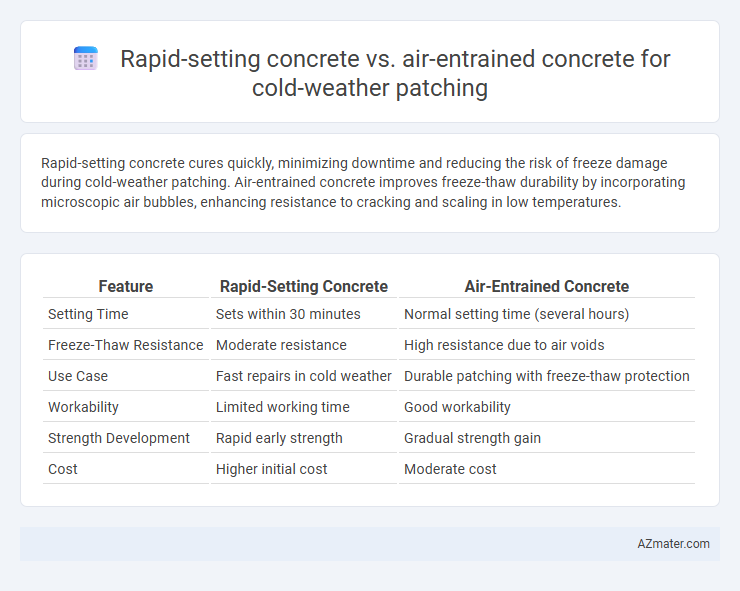Rapid-setting concrete cures quickly, minimizing downtime and reducing the risk of freeze damage during cold-weather patching. Air-entrained concrete improves freeze-thaw durability by incorporating microscopic air bubbles, enhancing resistance to cracking and scaling in low temperatures.
Table of Comparison
| Feature | Rapid-Setting Concrete | Air-Entrained Concrete |
|---|---|---|
| Setting Time | Sets within 30 minutes | Normal setting time (several hours) |
| Freeze-Thaw Resistance | Moderate resistance | High resistance due to air voids |
| Use Case | Fast repairs in cold weather | Durable patching with freeze-thaw protection |
| Workability | Limited working time | Good workability |
| Strength Development | Rapid early strength | Gradual strength gain |
| Cost | Higher initial cost | Moderate cost |
Understanding Rapid-Setting Concrete
Rapid-setting concrete achieves strength within hours by incorporating calcium chloride or other accelerators, making it ideal for cold-weather patching where quick curing is essential to prevent freeze damage. This type of concrete reduces downtime, allowing for faster reopening of roads or structures compared to traditional mixes. Its ability to gain early strength counteracts the slow hydration process in low temperatures, ensuring reliable performance in harsh conditions.
What is Air-Entrained Concrete?
Air-entrained concrete contains microscopic air bubbles intentionally introduced during mixing to improve freeze-thaw durability, making it ideal for cold-weather patching by reducing internal stress from ice expansion. Unlike rapid-setting concrete, which gains strength quickly for fast repairs, air-entrained concrete enhances long-term resistance to cracking and scaling in freezing and thawing cycles. This characteristic ensures structural integrity and longevity in pavements and repairs exposed to harsh winter conditions.
Key Properties of Rapid-Setting Concrete
Rapid-setting concrete offers accelerated curing times, enabling faster return to service in cold-weather patching applications where minimizing downtime is critical. Its high early strength development and resistance to freeze-thaw cycles make it ideal for rapid repairs exposed to harsh winter conditions. The concrete's low permeability and enhanced bond strength improve durability and longevity in freeze-thaw environments compared to standard air-entrained concrete.
Benefits of Air-Entrained Concrete in Cold Weather
Air-entrained concrete enhances freeze-thaw durability by incorporating microscopic air bubbles, which absorb ice expansion and prevent cracking during cold-weather patching. This concrete type improves workability and reduces scaling risks, ensuring longer-lasting repairs under fluctuating temperatures. Its superior resistance to moisture penetration makes it ideal for cold climates where frost action is prevalent.
Cold-Weather Patching: Challenges and Requirements
Rapid-setting concrete offers faster strength gain and reduced curing time, making it ideal for cold-weather patching where low temperatures slow conventional concrete setting. Air-entrained concrete improves freeze-thaw durability by incorporating microscopic air bubbles that prevent internal cracking, which is essential in harsh winter conditions. Combining rapid-setting properties with proper air entrainment can address the challenges of cold-weather patching by ensuring both timely strength development and enhanced resistance to freeze-thaw cycles.
Performance Comparison in Low Temperatures
Rapid-setting concrete achieves faster strength gain in low temperatures, allowing quicker traffic reopening and reduced downtime on cold-weather patches. Air-entrained concrete enhances freeze-thaw durability by incorporating microscopic air bubbles, minimizing internal stress and preventing cracking during freeze cycles. While rapid-setting concrete excels in early strength development under cold conditions, air-entrained concrete provides superior long-term resistance to freeze-thaw damage, making it essential for durability in sustained cold environments.
Setting Time and Workability Analysis
Rapid-setting concrete offers significantly shorter setting times, typically hardening within 30 to 60 minutes, which is ideal for cold-weather patching where low temperatures can delay normal curing processes. Air-entrained concrete enhances workability and durability by incorporating air bubbles that improve freeze-thaw resistance but has a longer setting time, generally several hours, which may slow repair operations in cold climates. Analyzing both, rapid-setting concrete prioritizes fast strength gain for minimal downtime, while air-entrained concrete provides better long-term resilience against cold-weather damage and surface scaling.
Durability and Freeze-Thaw Resistance
Rapid-setting concrete offers quick strength development, making it ideal for cold-weather patching where reduced downtime is critical, but it may have lower long-term durability compared to air-entrained concrete. Air-entrained concrete enhances freeze-thaw resistance by incorporating microscopic air bubbles that relieve internal pressure during freezing cycles, significantly improving durability in harsh winter conditions. The choice between the two depends on balancing immediate strength requirements with long-term freeze-thaw performance and durability needs.
Cost Considerations and Practical Applications
Rapid-setting concrete offers cost benefits in cold-weather patching by reducing labor time and minimizing the need for prolonged thermal protection, making it ideal for small repairs requiring quick turnaround. Air-entrained concrete, while typically more expensive due to entraining agents and additives, provides superior freeze-thaw durability and long-term performance in harsh cold environments, justifying the investment for larger or structural patches. Choosing between them depends on balancing upfront material costs with the application's durability requirements and time constraints.
Choosing the Right Concrete for Cold-Weather Patching
Rapid-setting concrete cures quickly, making it ideal for cold-weather patching as it minimizes the risk of freeze damage by reducing the time the concrete remains vulnerable. Air-entrained concrete contains microscopic air bubbles that improve freeze-thaw resistance, enhancing durability in freezing temperatures but requiring longer curing times. Selecting the right concrete depends on the project's urgency and weather conditions, with rapid-setting concrete preferred for fast repairs and air-entrained concrete suited for long-term durability in consistently cold environments.

Infographic: Rapid-setting concrete vs Air-entrained concrete for Cold-weather patching
 azmater.com
azmater.com